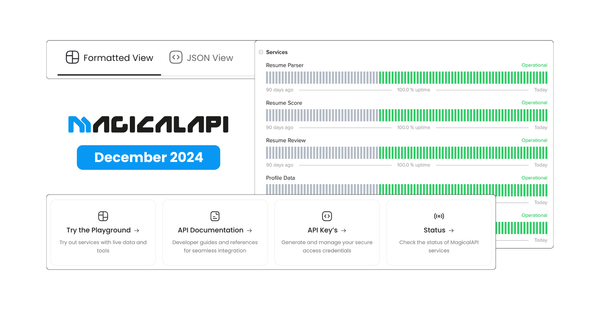How to Name Your Resume File: Best Practices and Tips for 2024
Discover top tips for naming your resume file in 2024. Make your resume stand out and pass Applicant Tracking Systems (ATS) with these effective strategies.

If you're wondering what to name your resume file, here's a simple guide for you. A good resume file name can help your application stand out and show your professionalism right away.
We'll cover the basics of choosing a strong resume file name and provide examples to inspire you. By following these best practices, you'll make a great first impression even before the hiring manager reads your resume.
✨ Unleash the Power of AI with MagicalAPI!
Whether you’re extracting LinkedIn data, or evaluating resumes, MagicalAPI is your one-stop solution! Discover the diverse range of AI services tailored to meet your every need. Dive in and elevate your digital experience today!

What Do I Name My Resume File?
Naming your resume file correctly can greatly improve your application's visibility and professionalism.
Here are some easy-to-follow guidelines to help you create a resume file name that stands out positively to recruiters and works well with Applicant Tracking Systems (ATS).
Include Your Full Name
Start your resume file name with your full name. This makes your resume easy to identify and sets it apart from others.
For example, "JohnDoe_Resume.pdf" is a good choice. If your name is common, you might want to add your middle initial or full middle name to make it unique.
Specify the Document Type
Clearly mention the type of document in the file name, like "Resume" or "CV". This helps recruiters know what the file is without opening it.
For example, "JaneSmith_CV.pdf" or "JaneSmith_Resume.pdf" are clear and easy to understand. This is especially helpful if you are submitting other documents like a cover letter or references.
Read more: CV, Resume vs Portfolio: What’s The Difference?
Add the Job Title
When applying for specific jobs, include the job title in your resume file name. This shows that you have tailored your resume for that particular role.
For example, "MichaelBrown_ProjectManager_Resume.pdf" makes it clear what job you are applying for. This can also help your resume get noticed in ATS systems.
Use Consistent Formatting
Keep your file names consistent. Choose a format and stick with it for all your application documents. You can use underscores or hyphens to separate words.
For example, always use "FirstName_LastName_JobTitle_Resume.pdf" to look professional and avoid confusion.
Avoid Special Characters
Don't use special characters like @, #, %, or & in your resume file name. Stick to letters, numbers, underscores, and hyphens. Special characters can cause errors when uploading or downloading files, so keep your file name simple.
Keep It Short but Descriptive
Make sure your resume file name is clear but not too long. A concise file name is easier to read and manage. Try to include all necessary details without making the name too lengthy.
Use Common File Extensions
Save your resume in a widely accepted format like PDF or DOCX. These formats are preferred by recruiters and work well with most ATS. Include the file extension in the file name, such as ".pdf" or ".docx".
By following these simple tips, you can make sure your resume is easy to identify and looks professional right from the file name.
Taking the time to name your resume file properly shows attention to detail and professionalism, which are qualities that employers appreciate.
Tips to Avoid Common Mistakes
Avoid Generic Names
When naming your resume file, avoid using generic names like "Resume" or "Document." These names can make your resume blend in with others, making it harder for hiring managers to find and remember your file.
Instead, use a clear and professional format with your full name followed by "resume." This helps your resume stand out and makes it easy for hiring managers to identify.
Don't Include Version Numbers
Using version numbers in your resume file name, like "Resume_2023_1" or "Resume-Sales-2," can make it seem less personal and unique. It suggests that your resume is just one of many versions, which might look like you didn't customize it for the job.
Always name your resume in a way that shows it is carefully tailored for the specific job you're applying for. This shows recruiters that you've put effort into making your application fit their needs.
Avoid Unconventional Symbols
To ensure your resume file is compatible and readable across different operating systems and software, avoid using unconventional symbols in the file name. Characters like slashes (/), backslashes (\), and angle brackets (<, >) can cause errors during file processing, especially when optimizing for Applicant Tracking Systems (ATS).
Stick to using simple characters such as hyphens (-), underscores (_), and alphanumeric characters (A-Z, 0-9). These symbols are universally accepted.
Examples of Proper Resume Names
Examples Based on Job Titles
When creating your resume file name, adding the job title you’re applying for can make your resume more relevant and noticeable. Here are some examples of how to include job titles in your resume file names:
- Robin-Walker-Marketing-Assistant-Resume.pdf
This format uses hyphens to separate the elements, making the file name easy to read and clearly targeted toward the specific job position. - Sarah_Connor_Software_Developer_Resume.pdf
Using underscores as separators, this example includes the full name and the specific job title, enhancing the professional tone and ATS compatibility. - Michael-Jones-Sales-Manager-Resume.pdf
Including the job title in your file name tells the hiring manager right away which position you're applying for. This helps them sort and prioritize your resume more easily.
These examples show why having a clear, job-specific resume file name is important. It helps hiring managers stay organized and works well with digital sorting systems like ATS.
Examples Including Specific Companies
Adding the company name to your resume file name can make your application feel more personal and show that you're really interested in the job. Here are some examples that include both the company name and the job title:
- Jane-Doe-Graphic-Designer-ABC-Corp-Resume.pdf
This file name clearly states the candidate’s name, the job title, and the company’s name, making it highly specific and tailored for a particular job application. - John-Smith-Project-Manager-Beta-Inc-Resume.pdf
Including the company name in the file name can significantly increase the chances that your resume will catch the attention of the hiring manager, as it shows a direct interest in the company. - Emily-Rivera-Customer-Support-Specialist-Toyota-Resume.pdf
This example not only specifies the job title but also the company name, which could be advantageous in a competitive job market by showing proactive interest and customization.
By using these clear and detailed examples, candidates can make sure their resume file names are informative and tailored for each job application. This improves their chances of being noticed and moving forward in the selection process.

Additional Tips for Resume File Naming
Tailor for Different Roles
If you're applying for different roles, make sure to customize each resume file name. This shows that you’ve put effort into tailoring your application for each job, which can impress recruiters.
Include Date of Application
Including the date in the file name can help both you and the recruiter keep track of when the application was submitted. For example, "JohnDoe_MarketingAssistant_Resume_2024.pdf".
Keep a Master Copy
Keep a master copy of your resume with a general file name, like "JohnDoe_MasterResume.pdf". This can be your base document from which you create tailored versions for different applications.
By following these best practices and tips, you can ensure that your resume file name is professional, clear, and tailored to the job you’re applying for, significantly enhancing your chances of making a positive first impression on recruiters and hiring managers.
Why Naming Your Resume is Important?
How you name your resume file is important because it’s the first thing employers see. A clear, descriptive name shows professionalism and helps recruiters find your resume easily. Including your name and job title makes your application stand out. Here’s why naming your resume file well is crucial: First Impressions Count.
- Impact on the Recruitment Process
Research shows that names can impact hiring decisions and how resumes are viewed. Studies have found that applicants with names that sound more "familiar" or "local" often get more positive responses, especially for leadership roles. This bias, whether intentional or not, can affect your chances of landing an interview. - Enhances Document Management
Recruiters get a lot of applications during the hiring process. A clear and descriptive resume file name helps them organize and find documents quickly. This way, they can spot the right files without opening each one, saving time and reducing the chance of missing your application. - Boosts Visibility in Applicant Tracking Systems
Many companies use Applicant Tracking Systems (ATS) to help with hiring. These systems look for specific keywords to sort and rank resumes. Including relevant keywords in your resume file name can make it more visible in these systems. This improves your chances of getting noticed and moving forward in the hiring process. - Reflects Your Brand and Professionalism
The way you name your resume file can reflect your personal brand and professionalism. A clear file name with your name and the role you’re applying for shows attention to detail and commitment. It also indicates that you’ve customized your application for the specific job, which can impress employers.
Take Your Resume to the Next Level
To improve your resume, try using Resume Review. This service gives expert feedback to make sure your resume is polished and suited to the jobs you’re applying for. Using good file naming along with this professional review can greatly boost your job application and increase your chances of getting the job you want.
Conclusion
In this article, we've highlighted the crucial steps for naming your resume file effectively. By including your full name and job title in a clear, professional format, you can ensure your resume stands out to hiring managers and navigates applicant tracking systems (ATS) more successfully. This small detail makes your resume easily identifiable, well-organized, and tailored to the role, boosting your chances in a competitive job market.
Properly naming your resume file showcases your professionalism and attention to detail—qualities highly valued across all industries. Whether you are new to the job market or an experienced professional, this simple step can set the stage for a positive first impression.
FAQ
- Why is it important to name my resume file properly?
Naming your resume file properly ensures it is easily identifiable by hiring managers and applicant tracking systems (ATS). A clear and professional file name can also create a good first impression. - What should I include in the file name?
Include your full name and the word "resume". Optionally, you can add the job title or a reference number for better specificity. - Should I use spaces in the file name?
Avoid spaces. Use hyphens or underscores instead, as they are more ATS-friendly.

Join to our community
By joining our Discord server, get assistance, and troubleshoot any challenges you may encounter while using our services.
Join us on Discord




